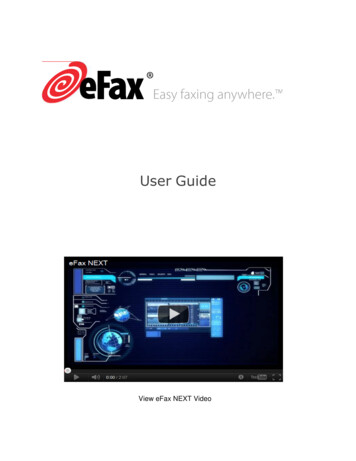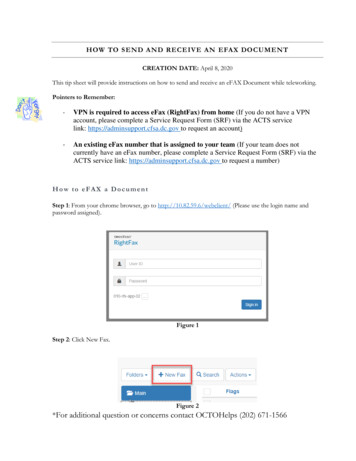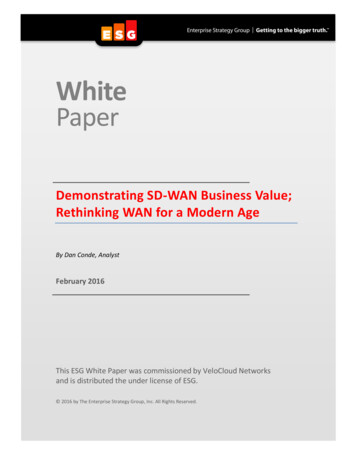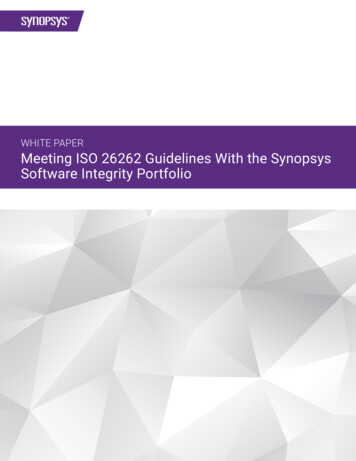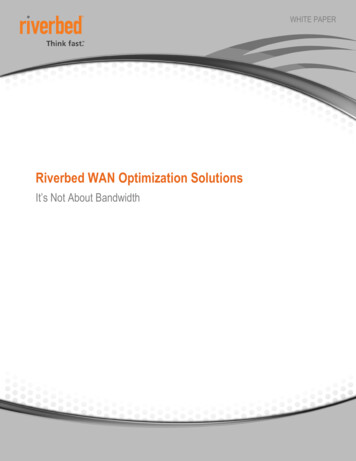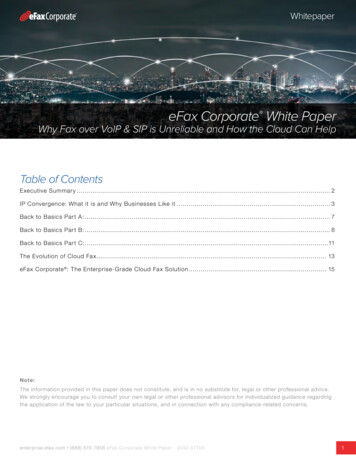
Transcription
WhitepapereFax Corporate White PaperWhy Fax over VoIP & SIP is Unreliable and How the Cloud Can HelpTable of ContentsExecutive Summary. 2IP Convergence: What it is and Why Businesses Like it. 3Back to Basics Part A:. . . 7Back to Basics Part B:. . . 8Back to Basics Part C:. .11The Evolution of Cloud Fax. . 13eFax Corporate : The Enterprise-Grade Cloud Fax Solution. . . 15Note:The information provided in this paper does not constitute, and is in no substitute for, legal or other professional advice.We strongly encourage you to consult your own legal or other professional advisors for individualized guidance regardingthe application of the law to your par ticular situations, and in connection with any compliance-related concerns.enterprise.efa x.com (888) 575-7958 eFa x Corporate White Paper - 2042-577061
WhitepaperExecutive SummaryOrganizations of all sizes, small, medium and largebusiness and enterprises, have been migrating legacyvoice networks to IP for going on two decades.The transition is nearly complete, although significantpockets of traditional analog and digital telephonyremain in operation and probably will for some time.But there is one application that has resisted the trendtowards convergence over IP. That application is Fax.Some of you may be surprised to learn that anyoneuses fax anymore. However, in the corporate world,especially in the more heavily regulated industriessuch as healthcare, insurance, finance, legal, etc., faxis still alive and in some cases usage is still growing.And with the rising number of hacked email accountsand other types of data breaches, traditional faxtransmission over the Public Switched TelehoneNetwork offers the perception of security andregulatory compliance.Fax was designed to work over analog lines oncircuit-switched networks and for the most part it hasnot successfully made the transition to packet-basednetworks, for reasons we will explain in this paper.IT-related blogs and community message boardsare replete with numerous stories and pleas forassistance with faxing over VoIP. The stories aredifferent but bear a common theme.It goes something like this. After cutting over to thenew VoIP system, complaints start trickling in tothe IT managers from various departments that stillneed to fax on a regular basis. If the company is inhealthcare, the fax volume can run into the tens ofthousands of pages per month.enterprise.efa x.com The trickle turns into a flood as the unreliabilityof faxing over VoIP starts to impact workflowsand productivity. After trying to fix the problem bytweaking various parameters on the analog-to-digitaladapters, the situation goes from bad to worse.Frustrated IT managers are forced to roll back faxon to the old telco lines that they had plannedto disconnect, giving up a good portion of theanticipated cost savings.But there is a better way, a forward looking solution thatpreserves the telco-disconnect monthly cost savingsand also eliminates the capital expense associated withmaintaining a traditional fax server system.That better way is to migrate fax to a Cloud-based‘efax‘ solution. Then there are no concerns withVoIP because the faxes are sent and received asemail attachments, riding over a secure, encryptednetwork to the final destination.So re ad on to le ar n more about the cur re ntstate of busine s s migration f rom le gacy to nex tge ne ration net wor ks.Then peruse a brief technical tutorial on thefundamentals of traditional telecommunications andnext-generation VoIP, SIP & FoIP protocols.And visualize how L AN/ WAN network architectureshave evolved over the years while faxing hasremained mostly the same.Finally, learn about the latest Cloud-based faxingsolutions that so many companies of all sizes areusing to bring fax-based communications securelyinto the modern age.(888) 575-7958 eFa x Corporate White Paper - 2042-577062
WhitepaperIP Convergence: What it is and Why Businesses Like itThis is a very brief explanation of why the InternetProtocol, or IP for short, has vastly improved theeconomics of local and wide area communications.First, let’s start with the idea of Convergence overIP--what is it, and why has it proven so beneficial tocorporations and business of all sizes?IP Convergence simply means integrating a company’svarious communication protocols onto a commonplatform. For most organizations this move begins withvoice communications.Voice over IP — or VoIP— is usually the catalyst forconvergence because the potential savings fromcombining parallel voice and data local networks intoone, or from reduced telco toll charges for outsidecalls, is so great.Often when businesses move their voice communicationsto VoIP, they discover that they can also move severalother interactive applications to the same IP network,including conferencing, email, instant messaging,video, etc. for a true multimedia experience.This convergence of these applications is oftenmarketed as ‘Unified Communications,’ or UC.However, one application that has often provenresistant to IP convergence is fax.And when organizations converge their entire communications systems onto their new VoIP platform,they often find out, only after the network has goneoperational, that the new environment creates allsorts of problems for those who need to send orreceive faxes on a regular basis.A trickle of complaints turns into a flood as more andmore departments discover, much to their dismay,that faxing has become unreliable at best, andcompletely non-functional at worst.enterprise.efa x.com After spending many hours trying to reconfigure theIP equipment, turning on some parameters, turningoff others, testing and retesting, getting some faxesto go through while others still fail, many IT managerswill take the path of least resistance and revert backto their legacy analog or digital fax infrastructure,which means re-installing costly telco lines for eachfax machine or server.Others will try to move forward, not back, and mayfind a more efficient way to move fax to the Cloud.We will discuss those alternatives in more detail later.But first here is a high-level overview of what camebefore IP and why packet protocols have proven sobeneficial to businesses of all types and sizes.Packetized communications overIP are vastly more efficient andcost-effective than traditionalcircuit-switched networks.Before Packets was the PSTNThe traditional phone network — sometimes calledthe Public Switched Telephone Network, or PSTN—is built on the technology that’s been aroundbasically since the introduction of the phone itself –circuit switching. This process creates a connectionbetween you and another caller across a series ofdedicated circuits.When you speak, your voice is transmitted as analogor digital signals across this circuit network, which iscomprised mainly of copper wires at each end of theconnection. If you are in a large downtown office building,that connection is likely to be on a fiber optic line.(888) 575-7958 eFa x Corporate White Paper - 2042-577063
WhitepaperOver the past 50 years the telephone network hasenjoyed some significant improvements such as thetransformation from analog to digital switching whichmade many new ‘intelligent’ features available, andthe replacement of copper with fiber optics on thelong haul transmission routes for increased capacityand reliability.It’s worth pointing out that the public telephonenetwork was engineered over the past 100 or soyears to do one thing – allow two or more peoplelocated pretty much anywhere in the world to engagein live conversations.The PSTN does that one thing very well and withvery high reliability, at least in countries that have adeveloped industrial infrastructure.IP – A Packet Here, A Packet There.With IP-based networks, on the other hand, ‘data’ —including voice, or video, — is broken down into chunksof information called packets. Similar to a postal mailenvelope for sending a letter, each packet has not onlythe data inside the packet, but also information neededto deliver that data to the correct destination.These packets are then sent over the Internet, wherethey are forwarded through a series of routers andswitches that keep the packets moving to the finaldestination. Some packets may get lost or droppedalong the way, by design, but the system can toleratesome packet loss; it can even request retransmissionof missing packets.Because the IP protocol can carry any type ofapplication, voice, data, video, etc. broken down intosmall packets, it allows services that used to requirededicated networks to share the same wire. Andthat application traffic can also be compressed foradditional bandwidth savings.Plus, the more unified your converged communicationsystem, the fewer platforms your IT departmentwill need to spend time monitoring, upgrading andtroubleshooting.enterprise.efa x.com Business Adoption of VoIPIP-based telephony systems, particularly thosehosted in the cloud, are far more flexible and easier toconfigure through than traditional phone systems, whilemoves, adds, and changes are relatively effortless.This ease of use is often one main reason mostbusinesses have chosen to upgrade from legacyphone systems to VoIP.Now let’s look at the current state of migration fromlegacy phone systems to IP. Here is a 2015 BusinessVoIP Buyer Report from the research firm SoftwareAdvice, a subsidiary of Gartner. This researchfocused on small businesses with up to 50 million inannual revenues, but it offers good insight into whybusiness buyers are upgrading voice to IP.As you can see, the greatest number of businessessurveyed in 2015 reported they are already usingVoIP, but a significant number of businesses continueto use legacy analog POTS lines or Primary RateInterface (PRI - a standard form of digital Software Advice: are-smb-buyer-trends-2015/The research also shows that 29% of smallbusinesses use VoIP for their premises phone system,either an IP-PBX or a cloud-hosted PBX, while only15% are still using traditional systems. Some arenot using any wired service at all--8% report thatemployees rely on mobile devices and wirelessservices exclusively.(888) 575-7958 eFa x Corporate White Paper - 2042-577064
WhitepaperCloud Fax – A Top 3 ApplicationEnterprise Migration to the CloudThe next three most popular applications are;automatic call distribution (ACD) for contact centerapplications; Internet (or Cloud)-based Fax to replacefax machines and fax servers; and Softphone, whichruns on a personal computer or mobile device.However, the majority of these IP systems are stillentirely on-premises; just 7% have migrated allcommunications to the Cloud, while 20% of SMBshave done so.The research also shows that the leading applicationby a large margin is auto attendant, which replacesthe receptionist by requiring callers to select the typeof service they want (“press 1 for customer service”).Most Popular VoIP Applications60In other words, they’ve found the value in convergingvarious communication technologies onto IP, but forvarious reasons they have been slow to take the nextstep--moving these platforms entirely to the 1%Internet Softphone CenferencingCellComputer DialerFaxRecording resources/voip-softwaresmb-buyer-trends-2015/And finally, the research the reveals the reason so manybusinesses are migrating to VoIP –- legacy PBXs areold and approaching their end-of-life. In some cases theoriginal vendor has been out of business for years, as in theexample of Nortel Networks, whose Norstar and Meridianphone systems were once ubiquitous in offices of all sizes.For those that still have traditional office phone systems,which are based on a technology known as TDM (timedivision multiplexing), the survey shows that many arefacing a wide range of problems around scalability, thecost or inability to replace aging hardware and software,and a lack of new features and applications.enterprise.efa x.com What about the larger enterprises? Well, accordingto a report on convergence from research firmIDG, large enterprises, which the study definesas businesses with over 1,000 employees, haveconverged most communications on an IP platform.And what are those reasons?The report cites as one explanation the fact that manylarge enterprises invested heavily in premises systemsover the past 5-10 or more years before there werea lot of cloud-based options. So they are naturallygoing to maximize their return-on-investment fromthese in-house systems first.Another reason is security. Many large organizationsfear moving their voice and data communicationsystems to the cloud because they worry abouthaving critical com-munications exposed to threatsoutside the corporate firewall.The IDG report also reports estimates that by 2017,the number of large enterprises who have moved theirconverged communication networks fully to the cloudwill double – to about 15%.What about the other 85%? The larger enterprisesare, for the most part, managing businesscommunications using a hybrid of the premise- andcloud-based models. In this approach, a business willkeep some of its communications systems in-housewhile outsourcing others to the cloud.(888) 575-7958 eFa x Corporate White Paper - 2042-577065
WhitepaperHere faxing is a good example — because IT managersoften find that when they try to migrate fax over to the newVoIP system they encounter numerous technical problems.So the IT team will fire up the old analog fax lines andmaintain the legacy fax-servers in-house, giving upmany of the anticipated cost savings.Or, if they are more progressive, they retire the legacyinfrastructure and move to a Cloud-based fax solution.Enterprise Migration to VoIPWhen asked about migration to Cloud-based IPCommunications, which includes VoIP, Video andUnified Communications, most companies today areusing premises-based systems, but the long termtrend is towards moving those systems to the Cloud.For example, the Website No Jitter reports that thepercentage using Cloud (hosted) PBX will rise 11% in2017, to 28%.Business Migration to Cloud CommunictionsEnterprise MigrationCloud Communications40%Cloud PBX28%30%Premise PBX72%20%10%0%Source: No JitterHybrid CloudSMBAll CloudEnterpriseAs you can see here, fairly similar proportions oforganizations, 30% of large enterprises and 27% ofSMBs, are using the hybrid approach today.IDG projects that within 2 years the number ofenterprises using the hybrid model will jump to 54%,and SMBs will increase to 47%.What this suggests is that, particularly among largerenterprises, there’s still some friction with moving tothe cloud – even though these businesses know thebenefits in cost savings, time savings and efficiency.Many companies also have a mix of premises andcloud, and some will never go entirely to the Cloud.The determining factor seems to be if the IT staff hasthe telephony expertise to managed VoIP networks.Companies that do not have the in-house expertise aremore likely to outsource communications to the cloud.The sweet spot of the market today is clearly with thesmall to mid-sized companies, as shown below.Cloud PBX By Company Size 10,00014%So they plan to take the incremental approach, toslowly move pieces of their communications to anoutsourced, hosted model over time.enterprise.efa x.com (888) 575-7958 eFa x Corporate White Paper - 2042-57706500-9,99940%1-49946%Source: No Jitter6
WhitepaperBack to Basics Part A: T1 & PRI PBXTelephony has come a long way over the past fewyears, evolving from analog to digital to packet-basedunified communications that converge voice, video, textmessaging and more on common platform. So let’sbriefly review the basics of these protocols, becausein order to know where the technology is going, it isimportant to understand from where it came.1. Analog. The natural world is an analog world.When you speak, your voice passes through theair as a waveform, and as anyone who as a childexperimented with two cans and a string knows, thataudible wave can be made to vibrate along the string,and be heard and understood at the other end.This is the technology that was first put into actionby Alexander Graham Bell and has persisted forover 100 years. Electronic signals over copper wirereplaced the vibrating sting, but the concept is thesame. Analog lines from the telephone company,sometimes referred to as Plain Old Telephone Service(POTS) lines, run about 50/month and they cannotbe shared, so every fax machine would need one.2. Digital Digital telephony is more like the earliertelegraph from the 1880s, except with one’s andzero’s replacing dots and dashes. T1 and PRI arecommon types of digital telephony that are still inwide use.3. PCM. Analog voice is converted to digital bysampling the voice wave at regular intervals, 8thousand times per second, which gives a prettygood representation of vocal sounds.This process produces a 64 kilobits per second(kbps) stream of digital data (that’s because those8000 samples have 8 bits each; 8000 x 8 64000).enterprise.efa x.com TimeThe process is reversed at the receiving end, turningthe digital stream back into analog (voice) sounds.And by the way, this process, known as Pulse CodeModulation (PCM) works for fax tones as well asvoice, so remember that 64kbps number; we willcome back to it a little later.PCM sends digitized voice over a wire at 64kbps,but that is only one call per line; not very efficient forlarge numbers of calls at bigger companies.4. TDM – time division multiplexing, allows multiplecalls to share the same wire. In TDM, every call gets anequal slice of bandwidth at a particular point in time.In technical terms, each call gets a fixed “timeslot” atregular repeating intervals, as shown in the diagrambelow. So even though multiple calls can share thesame wire, because they are divided by time, one callnever interferes with another.ABCDSending Digital Devices(888) 575-7958 eFa x Corporate White Paper - 2042-57706TDM FrameDCBTimeslotsABCDATime Division Multiplexing PCM & TDM1514131211109876543210Time Division Multiplexing Analog & DigitalPCM Digital Sampling Analog Voice WaveABCDReceiving Digital Devices7
WhitepaperTDM is thus said to be “deterministic” in contrast topacket-based services like Voice-over-IP, which arenot. We will talk more about that that later.5. T1. T1 is a digital communications servicedeveloped in the 1960s and still in widespread usetoday, although it is well past its peak. By applyingTDM, a voice T1 line can carry 24 digital voice calls,or ‘channels.’Since each call uses 64kbps, the bandwidth of a‘channelized’ T1 is 1.544 Mbps (24 x 64kbps, plusa little bit of overhead). A ‘data’ T1 can also providea single, ‘clear’ channel of 1.5 Mbps symmetricbandwidth for Internet access.An Internet T1 in a metro area has retail monthlypricing starting at around 200 and up. And thatbandwidth is symmetric — equal in both directions,which is why T1 is better suited than Broadband (withits asymmetric bandwidth) for businesses that need tosend, as well as receive, data.T1s can also be ‘bonded’ to cr
enterprise.efax.com (888) 575-7958 eFax Corporate White Paper - 2042-57706 3 Whitepaper IP Convergence: What it is and Why Businesses Like it This is a very brief explanation of why the Internet Protocol, or IP for short, has vastly improved the
